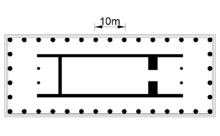| Temple of Heracles, Agrigento | |
|---|---|
 Columns of the Temple of Heracles Columns of the Temple of Heracles | |
| General information | |
| Location | Agrigento, Sicily |
| Coordinates | 37°17′25″N 13°35′11″E / 37.29028°N 13.58639°E / 37.29028; 13.58639 |
The Temple of Heracles or Temple of Hercules (the Roman name of the hero) is an ancient Greek temple of Magna Graecia in the ancient city of Akragas, located in the Valle dei Templi in Agrigento, Italy.
The building, in the archaic Doric style, is found on what is known as the hill of the temples, on a rocky spur near Villa Aurea. The name Temple of Heracles is an attribution of modern scholarship, based on Cicero's mention of a temple dedicated to the hero non longe a foro "not far from the agora" (Verrine II 4.94), containing a famous statue of Heracles. That the agora of Akragas was in this area has not yet been demonstrated, but the identification is generally accepted.
This temple is located approximately one kilometer to the west of Temple of Concordia.
History
The traditionally accepted chronology of the temple identifies it as the most ancient of the Greek Akragantine temples, dating to the final years of the 6th century BC. This dating is based on stylistic characteristics, especially its proportions, number of columns, and the profile of the columns and of their capitals. However, some connect the temple with the activities of Theron (Tyrant of Akragas 488-473/2 BC), claiming that it contains innovations compared to the architectural practice of the 6th century. In that case, it could be identified with the temple of Athena recorded by Polyaenus (Stratagems 6.51) in relation to the building activities of Theron after his seizure of power.
The remains of the entablature constitute a problem for dating, because there are two types of cymatium with gutters and lion heads: the first, less well-preserved than the other, datable to the 460s BC and the second datable to around the middle of the fifth century. Probably the first cymatium is the original and was replaced by the second a few decades later (for reasons unknown). The temple's foundation is considered to be dated to the years before the Battle of Himera (480 BC); its completion would have taken a decade or maybe a little more.
The building was restored in the Roman period with some modifications. The naos was divided into three, which could indicate a dedication to multiple divinities. If still in use by the 4th and 5th centuries, it would have been closed during the persecution of pagans in the late Roman Empire.
In the 20th century, restorers have reconstructed nine of the columns on the southeastern side through anastylosis. In addition, they restored part of the entablature and some of the capitals.
Architecture

The building was constructed on a crepidoma of three steps, which was erected on top of a substructure on the northern and western sides (due to the roughness of the terrain). It is a peripteros temple of unusually elongated proportions (67 metres long and 25.34 meters wide), with six columns along the front (hexastyle) and fifteen columns on the sides. Inside the peristasis is a long naos, bounded by a pronaos at the front and an opisthodomos at the back, both in antis. Their remains seem to indicate that the building was destroyed by an earthquake.
In the building's remains, internal stairs for the inspection of the roof can be seen in the walls between the pronaos and the naos. Such stairs became a typical feature of Akragantine temples. The tall columns are topped by wide capitals, with a deep gulf between the stem and the echinus. This feature might indicate the comparative antiquity of the building (predating the other peripteros temples at Akragas by at least thirty years), along with the elongation of the naos and the wide separation of the columns from the naos. On the eastern side of the temple are the remains of the large altar of the temple.
See also
References
- "Tempio di Eracle". Archived from the original on 10 October 2011. Retrieved 12 August 2011.
- Ernesto De Miro, Agrigento, 2000. ISBN 8882650480, p.86
- Ernesto De Miro, La Valle dei Templi di Agrigento, 1986, p.8
- René van Coppernole, "La signoria di Terone" in Agrigento e la Sicilia greca: Atti della Settimana di Studio, 1995, ISBN 8870627993, pp.70-71

